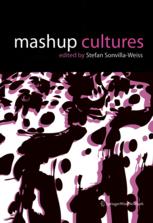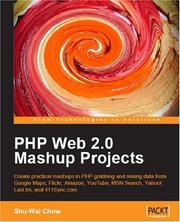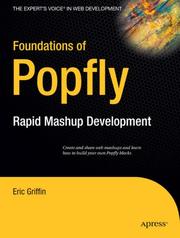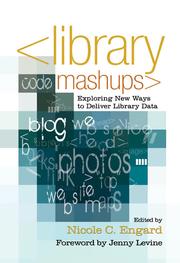| Listing 1 - 10 of 11 | << page >> |
Sort by
|

ISBN: 9783709100950 Year: 2010 Publisher: Wien Springer
Abstract | Keywords | Export | Availability | Bookmark
 Loading...
Loading...Choose an application
- Reference Manager
- EndNote
- RefWorks (Direct export to RefWorks)
Appropriation (Art) --- Interactive art --- Mashups (World Wide Web) --- New media art --- Social media --- Web 2.0
Book
ISBN: 3642550487 3642550495 Year: 2014 Publisher: Berlin, Heidelberg : Springer Berlin Heidelberg : Imprint: Springer,
Abstract | Keywords | Export | Availability | Bookmark
 Loading...
Loading...Choose an application
- Reference Manager
- EndNote
- RefWorks (Direct export to RefWorks)
Mashups have emerged as an innovative software trend that re-interprets existing Web building blocks and leverages the composition of individual components in novel, value-adding ways. Additional appeal also derives from their potential to turn non-programmers into developers. Daniel and Matera have written the first comprehensive reference work for mashups. They systematically cover the main concepts and techniques underlying mashup design and development, the synergies among the models involved at different levels of abstraction, and the way models materialize into composition paradigms and architectures of corresponding development tools. The book deliberately takes a balanced approach, combining a scientific perspective on the topic with an in-depth view on relevant technologies. To this end, the first part of the book introduces the theoretical and technological foundations for designing and developing mashups, as well as for designing tools that can aid mashup development. The second part then focuses more specifically on various aspects of mashups. It discusses a set of core component technologies, core approaches, and architectural patterns, with a particular emphasis on tool-aided mashup development exploiting model-driven architectures. Development processes for mashups are also discussed, and special attention is paid to composition paradigms for the end-user development of mashups and quality issues. Overall, the book is of interest to a wide range of readers. Students, lecturers, and researchers will find a comprehensive overview of core concepts and technological foundations for mashup implementation and composition. Even without low-level coding details, practitioners like software architects will find guidance on key implementation concepts, architectural patterns, and development tools and approaches. A related website provides additional teaching material which can be used either as part of a course or for self study.
Computer science. --- Software engineering. --- Computer Science. --- Information Systems Applications (incl. Internet). --- Software Engineering. --- Computer software engineering --- Engineering --- Mashups (World Wide Web) --- Application software. --- Application computer programs --- Application computer software --- Applications software --- Apps (Computer software) --- Computer software

ISBN: 1281252425 9786611252427 1847190898 184719088X 9781847190888 9781847190895 9781847190888 Year: 2007 Publisher: Birmingham, U.K. : Packt Pub.,
Abstract | Keywords | Export | Availability | Bookmark
 Loading...
Loading...Choose an application
- Reference Manager
- EndNote
- RefWorks (Direct export to RefWorks)
Create practical mashups in PHP grabbing and mixing data from Google Maps, Flickr, Amazon, YouTube, MSN Search, Yahoo!, Last.fm, and 411Sync.com
Mashups (World Wide Web) --- PHP (Computer program language) --- Web services. --- Web sites --- Web 2.0. --- World Wide Web --- Web site development --- Microformats --- Application software --- Cloud computing --- Personal Home Page (Computer program language) --- Programming languages (Electronic computers) --- Design. --- Authorship
Book
ISBN: 9781442246898 9781442246904 9781442246911 9781442247871 9781442247864 Year: 2015 Publisher: Lanham, Md Rowman & Littlefield
Abstract | Keywords | Export | Availability | Bookmark
 Loading...
Loading...Choose an application
- Reference Manager
- EndNote
- RefWorks (Direct export to RefWorks)
Carol Smallwood's The Complete Guide to Using Google in Libraries, Volume 1: Instruction, Administration, and Staff Productivity explores how Google's suite of tools, from Google Docs (now Google Drive), Google Scholar, Hangout, Forms, and others made freely available to the Internet Community, can be used by libraries to expand the role of digital operations in the management of library materials, to communicate with their patrons and collaborators, to exploit the resources on the Web, and many others. The Complete Guide to Using Google in Libraries, Volume 2: Research, User Applications, and Networking has 30 chapters divided into four parts: Research, User Applications, Networking, Searching. The contributors are practitioners who use the services they write about and they provide how-to advice that will help public, school, academic, and special librarians; library consultants, LIS faculty and students, and technology professionals.
Mass communications --- Computer architecture. Operating systems --- Documentation and information --- Web applications in libraries --- Mashups (World Wide Web) --- Applications Web dans les bibliothèques --- Applications composites (Web) dans les bibliothèques --- Library applications --- Google. --- Applications Web dans les bibliothèques --- Applications composites (Web) dans les bibliothèques

ISBN: 1281218065 9786611218065 1430205687 1590599519 Year: 2008 Publisher: Berkeley, Calif. : Apress,
Abstract | Keywords | Export | Availability | Bookmark
 Loading...
Loading...Choose an application
- Reference Manager
- EndNote
- RefWorks (Direct export to RefWorks)
Author Eric Griffin shows you how to mix applications and share your hybrids with the world, using the Popfly Mashup Creator and Popfly Web Page Creator.
Mashups (World Wide Web) --- Web 2.0. --- Web site development. --- Web sites --- Design. --- Web site development --- Microformats --- Development of Web sites --- Internet programming --- World Wide Web --- Authorship --- Development --- Information Technology --- Computer Science (Hardware & Networks) --- Computer programming. --- Software engineering. --- Web Development. --- Software Engineering/Programming and Operating Systems. --- Computer software engineering --- Engineering --- Computers --- Electronic computer programming --- Electronic data processing --- Electronic digital computers --- Programming (Electronic computers) --- Coding theory --- Programming
Book
ISBN: 3709112621 370911263X Year: 2012 Publisher: Wien ; New York : Springer,
Abstract | Keywords | Export | Availability | Bookmark
 Loading...
Loading...Choose an application
- Reference Manager
- EndNote
- RefWorks (Direct export to RefWorks)
Remix Theory: The Aesthetics of Sampling is an analysis of Remix in art, music, and new media. Navas argues that Remix, as a form of discourse, affects culture in ways that go beyond the basic recombination of material. His investigation locates the roots of Remix in early forms of mechanical reproduction, in seven stages, beginning in the nineteenth century with the development of the photo camera and the phonograph, leading to contemporary remix culture. This book places particular emphasis on the rise of Remix in music during the 1970s and '80s in relation to art and media at the beginning
Music and technology. --- Music --Instruction and study --Technological innovations. --- Rock music -- History and criticism. --- Art, Architecture & Applied Arts --- Fine Arts - General --- Appropriation (Art) --- Sampling (Sound) --- Remixes. --- Mashups (World Wide Web) --- Aesthetics, Modern --- Aesthetics --- World Wide Web --- Club mixes --- Dance mixes --- Mixes (Music) --- Electronic music --- Electronic dance music --- Sound recordings --- Digital sound sampling --- Sound sampling --- Computer sound processing --- Appropriated imagery --- Appropriated images --- Appropriationism (Art) --- Postmodernism --- Imitation in art --- History --- Remixing
Book
ISBN: 1281675598 9786611675592 1430209968 143020995X 9781281675590 9781430209966 Year: 2008 Publisher: Berkeley, CA : New York : Apress ; Distributed to the book trade in the U.S. by Springer-Verlag New York,
Abstract | Keywords | Export | Availability | Bookmark
 Loading...
Loading...Choose an application
- Reference Manager
- EndNote
- RefWorks (Direct export to RefWorks)
Have a Google Maps mashup that you'd like to expose to millions of users on maps.google.com? New to the mapping craze, but have an idea for a killer map–based application? Want to learn how to create GeoRSS and KML feeds with your geotagged content, exposing your customer to new ways of exploring and navigating your content? Google Maps Mashups with Google Mapplets Is the first book to cover Google's Mapplet technology Shows you how to create Google Maps–based applications and publish to maps.google.com Provides a single–source resource and practical guide to Mapplets and mashups Teaches you how to mash up Mapplets using location–specific data Includes examples of real–world applications.
Application program interfaces (Computer software) --- Geographic information systems. --- Maps --- Mashups (World Wide Web) --- Computer network resources. --- Google Maps. --- World Wide Web --- Plans --- Cartographic materials --- Geography --- Cartography --- Geographical information systems --- GIS (Information systems) --- Information storage and retrieval systems --- APIs (Computer software) --- Interfaces, Application program (Computer software) --- Application software --- Information Technology --- Computer Science (Hardware & Networks) --- General and Others --- Computer programming. --- Software engineering. --- Web Development. --- Software Engineering/Programming and Operating Systems. --- Computer software engineering --- Engineering --- Computers --- Electronic computer programming --- Electronic data processing --- Electronic digital computers --- Programming (Electronic computers) --- Coding theory --- Programming

ISBN: 9781573873727 1573873721 Year: 2009 Publisher: Medford Information Today
Abstract | Keywords | Export | Availability | Bookmark
 Loading...
Loading...Choose an application
- Reference Manager
- EndNote
- RefWorks (Direct export to RefWorks)
Mashups (World Wide Web) --- Libraries and the Internet. --- Library Web sites --- Web site development. --- Applications composites (Web) dans les bibliothèques --- Bibliothèques et Internet --- Sites Web de bibliothèques --- Sites Web --- Library applications. --- Design. --- Design --- Développement --- 610 Informatiecentra. Algemeen --- 096 Informatica --- -Libraries and the Internet --- -Web site development --- 020.2854678 --- Development of Web sites --- Web sites --- Internet programming --- Web librarianship --- Internet and libraries --- Internet --- Library applications --- Development --- Applications composites (Web) dans les bibliothèques --- Bibliothèques et Internet --- Sites Web de bibliothèques --- Développement --- Libraries and the Internet --- Web site development

ISBN: 1281314471 9786611314477 1430202866 159059858X 9781590598580 Year: 2008 Publisher: Berkeley, CA : New York : Apress ; Distributed to the book trade worldwide by Springer-Verlag New York,
Abstract | Keywords | Export | Availability | Bookmark
 Loading...
Loading...Choose an application
- Reference Manager
- EndNote
- RefWorks (Direct export to RefWorks)
How many times have you seen a web site and said, “This would be exactly what I wanted— if only . . . ” If only you could combine the statistics here with data from your company’s earnings projections. If only you could take the addresses for those restaurants and plot them on one map. How often have you entered the date of a concert into your calendar with a single click instead of retyping? How often do you wish that you could make all the different parts of your digital world—your e-mail, your word processor documents, your photos, your search results, your maps, your presentations—work together more seamlessly? After all, it’s all digital and malleable information—shouldn’t it all just fit together? In fact, below the surface, all the data, web sites, and applications you use could fit together. This book teaches you how to forge those latent connections—to make the Web your own—by remixing information to create your own mashups. A mashup, in the words of the Wikipedia, is a web site or web application “that seamlessly combines content from more than one source 1 into an integrated experience. ” Learning how to draw content from the Web together into new integrated interfaces and applications, whether for yourself or for other others, is the central concern of this book.
Web 2.0. --- Mashups (World Wide Web) --- Web site development. --- Development of Web sites --- Web sites --- Internet programming --- World Wide Web --- Development --- Information Technology --- Computer Science (Hardware & Networks) --- Computer programming. --- Software engineering. --- Web Development. --- Software Engineering/Programming and Operating Systems. --- Computer software engineering --- Engineering --- Computers --- Electronic computer programming --- Electronic data processing --- Electronic digital computers --- Programming (Electronic computers) --- Coding theory --- Programming --- Web 2.0 --- Web site development --- 681.3*H1 --- 681.3*H35 --- 681.3*H43 --- 681.3*H43 Communications applications: electronic mail; teleconferencing; videotex (Information systems applications) --- Communications applications: electronic mail; teleconferencing; videotex (Information systems applications) --- 681.3*H35 On-line information services: data bank sharing --- On-line information services: data bank sharing --- 681.3*H1 Models and principles (Information systems) --- Models and principles (Information systems) --- Computer architecture. Operating systems --- Information systems
Book
ISBN: 3319287265 3319287273 Year: 2016 Publisher: Cham : Springer International Publishing : Imprint: Springer,
Abstract | Keywords | Export | Availability | Bookmark
 Loading...
Loading...Choose an application
- Reference Manager
- EndNote
- RefWorks (Direct export to RefWorks)
This book constitutes the refereed proceedings of the First International Rapid Mashup Challenge, RMC 2015, held on June 23, 2015, in Rotterdam, The Netherlands, in conjunction with the 15th International Conference on Web Engineering, ICWE 2015. The 2015 edition of the challenge is the first installment of a series of challenges that aim to engage researchers and practitioners in a competition for the best mashup approach. The 6 thoroughly reviewed contributions contained in this volume are extended versions of the initial proposals that served the authors to express their interest to participate in the challenge. The initial proposals have been used by the challenge organizers to select participants based on the interestingness and maturity of the proposals.
Computer Science --- Engineering & Applied Sciences --- Software engineering. --- Computer science. --- Information systems. --- Information storage and retrieva. --- Information Systems Applications (incl. Internet). --- Software Engineering. --- User Interfaces and Human Computer Interaction. --- Computer Appl. in Administrative Data Processing. --- Information Storage and Retrieval. --- Computer software engineering --- Engineering --- Informatics --- Science --- Information storage and retrieval systems. --- Automatic data storage --- Automatic information retrieval --- Automation in documentation --- Computer-based information systems --- Data processing systems --- Data storage and retrieval systems --- Discovery systems, Information --- Information discovery systems --- Information processing systems --- Information retrieval systems --- Machine data storage and retrieval --- Mechanized information storage and retrieval systems --- Computer systems --- Electronic information resources --- Data libraries --- Digital libraries --- Information organization --- Information retrieval --- Mashups (World Wide Web) --- World Wide Web --- Application software. --- User interfaces (Computer systems). --- Information storage and retrieval. --- Application computer programs --- Application computer software --- Applications software --- Apps (Computer software) --- Computer software --- Interfaces, User (Computer systems) --- Human-machine systems --- Human-computer interaction
| Listing 1 - 10 of 11 | << page >> |
Sort by
|

 Search
Search Feedback
Feedback About UniCat
About UniCat  Help
Help News
News